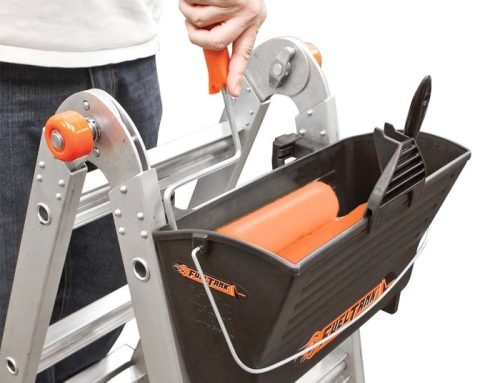Roof ladders are specially designed and built for rooftop access. They come in single and extending models and there is a system built by PROCAT that consists of separate sections that can be joined together to make a roof ladder of the perfect length every time. There are also folding models available, which can be folded down a lot smaller than extending models and also give the flexibility of length that a sectional roof ladder system offers.
So, What’s Different About Roof Ladders?
What makes a roof ladder unique is the hook at the top and the wheels on the front of the ladder itself. The wheels are used to roll the ladder up the roof surface (this approach stops damage to the tiles). When the wheels are at the top of the roof, the ladder can be turned over and the hooks (or hook) keep the roof ladder in place. Most dedicated roof ladders also have weight spreading bars on the back of the ladder, which even out the weight impact on the roof, helping to avoid damage to the tiles.
Roof ladders tend to be made from aluminium as it is strong and lightweight. They are used most often by tradespeople such as satellite installers, chimney repairers and most obviously, roofers. It is possible to turn a normal aluminium ladder into a roof ladder with a ladder hook, which attaches to any standard ladder and provides the all important roof hook fixing that makes it into a roof ladder. The best ladder hook also has a wheeled part, which helps get the ladder into position on the roof.
When using a roof ladder the hardest part is getting the ladder into position. Although roof ladders are designed to be reasonably easy to position (the wheels help), the challenge is getting the roof ladder up to the roof in the first place. The ladder used to access the gutter level should be long enough that at least three rungs protrude above the guttering line and the ladder should be made secure and stable on the ground. Always use a second person to help get the roof ladder from the ground onto the roof, via the access ladder. Roof ladders can be quite heavy, so it is not a good idea to try and climb a ladder whilst holding one. A far safer option is to climb the first ladder and have someone else pass the roof ladder up to you.
Roof Ladders and Safety
Once the roof ladder is in position on the roof, it is a good idea to clamp the roof ladder to the access ladder to prevent them coming apart or falling when you move from one ladder to the other. Even though you will probably have someone else with you when setting up and using roof ladders, if the access ladder falls and you are alone, you could be stuck on the roof for a while and the access ladder falling could injure someone on the ground.
It is also a good idea to invest in a roof ladder safety kit, which includes a harness, rope, karabiner, tensioning straps and other safety accessories that keep you attached to the ladder, avoiding the danger of slipping from the ladder and then falling off the roof. Safety equipment like this is especially important if using a roof ladder in wet conditions (which we would not advise you do), as the combination of wet roof tiles and wet aluminium is a very slippery one and a simple safety kit could save a life.
Midland Ladders has several different models of roof ladder from Lyte and PROCAT. If you’re wondering which might be best for you, please drop us a line – we’ll be happy to help.






Leave A Comment
You must be logged in to post a comment.